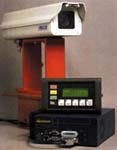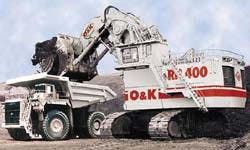Vision system detects missing shovel teeth
In surface-mining applications, large hydraulic shovels are often used to dig the mine surface. For example, the RH400 excavator from Orenstein and Koppel Inc. (Tulsa, OK) is capable of handling 52.3 to 58.9 cubic yards of material in its machine shovel bucket. When excavating in iron-ore, oil-sand, or coal mines, the machine arm can often engages rough material, causing parts of the bucket teeth to break off.
Since they are made of hardened steel, lost or broken teeth can cause serious damage to associated tools, conveyor belts, pumps, crushers, screens, and other equipment in the downstream processing plant. In particular, crushers can be damaged and may require several shifts to repair, causing serious production delays. On average, several incidents are reported per year, and a typical tooth-breakage incident can cost from tens to hundreds of thousands of dollars. There are also safety issues in-volved in attempts to find and remove the broken tooth from the processing plant.
Since the operators cannot see all of the bucket's teeth while seated in the machine cab, they can only examine tooth status periodically during operation. To overcome this problem, Motion Metrics (Vancouver, British Columbia, Canada) in collaboration with Alberta Research Council (Edmonton, Alberta, Canada) has developed an embedded, intelligent, machine-vision system to detect any missing bucket teeth.
"To image the bucket teeth in real time, a monochrome MC3820-3 CCD camera from Pelco (Clovis, CA) is fitted to the outside of the face shovel," says Shahram Tafazoli, Motion Metrics president and technical director. "The camera interfaces to a 4Sight system from Matrox Imaging (Dorval, Quebec, Canada) using the 4Sight embedded PC/104 Meteor2 frame grabber." Running under Windows NT Embedded, imaging information is displayed on an Optimate 640 panel from Optimation (Huntsville, AL) connected to the 4Sight system via an RS-232 interface. A proprietary algorithm embedded in the 4Sight PC processes digital images acquired by the CCD camera to show if any tooth on the machine bucket is missing.
"In each upswing of the shovel arm," says Tafazoli, "the presence of the empty bucket is detected, and the toothline is analyzed using several proprietary algorithms." The task is further complicated as the system must operate around the clock, regardless of weather conditions or environmental lighting. When it is confirmed that one of the teeth is broken or lost, an alarm is triggered. The machine operator informs the truck dispatcher, and the load inside the loading truck is dumped away."
In addition, the operator panel displays information such as the breakage possibility of each tooth after every upswing motion of the shovel arm. Green, yellow, and red lights on the panel inform the operator of the current tooth-breakage status, Tafazoli adds.
Currently being field tested by the Alberta Research Council on an RH400 excavator in a surface mine in Canada, the mining-shovel missing-tooth-detection system is due for market release sometime this year.


